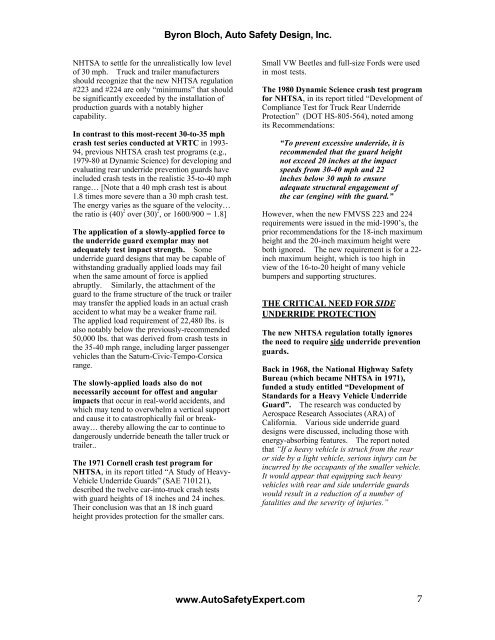Underride Protection
Formula 1 UNDERUN SAFETY A MUST
Formula 1 UNDERUN SAFETY A MUST
Create successful ePaper yourself
Turn your PDF publications into a flip-book with our unique Google optimized e-Paper software.
Byron Bloch, Auto Safety Design, Inc.<br />
NHTSA to settle for the unrealistically low level<br />
of 30 mph. Truck and trailer manufacturers<br />
should recognize that the new NHTSA regulation<br />
#223 and #224 are only “minimums” that should<br />
be significantly exceeded by the installation of<br />
production guards with a notably higher<br />
capability.<br />
In contrast to this most-recent 30-to-35 mph<br />
crash test series conducted at VRTC in 1993-<br />
94, previous NHTSA crash test programs (e.g.,<br />
1979-80 at Dynamic Science) for developing and<br />
evaluating rear underride prevention guards have<br />
included crash tests in the realistic 35-to-40 mph<br />
range… [Note that a 40 mph crash test is about<br />
1.8 times more severe than a 30 mph crash test.<br />
The energy varies as the square of the velocity…<br />
the ratio is (40) 2 over (30) 2 , or 1600/900 = 1.8]<br />
The application of a slowly-applied force to<br />
the underride guard exemplar may not<br />
adequately test impact strength. Some<br />
underride guard designs that may be capable of<br />
withstanding gradually applied loads may fail<br />
when the same amount of force is applied<br />
abruptly. Similarly, the attachment of the<br />
guard to the frame structure of the truck or trailer<br />
may transfer the applied loads in an actual crash<br />
accident to what may be a weaker frame rail.<br />
The applied load requirement of 22,480 lbs. is<br />
also notably below the previously-recommended<br />
50,000 lbs. that was derived from crash tests in<br />
the 35-40 mph range, including larger passenger<br />
vehicles than the Saturn-Civic-Tempo-Corsica<br />
range.<br />
The slowly-applied loads also do not<br />
necessarily account for offest and angular<br />
impacts that occur in real-world accidents, and<br />
which may tend to overwhelm a vertical support<br />
and cause it to catastrophically fail or breakaway…<br />
thereby allowing the car to continue to<br />
dangerously underride beneath the taller truck or<br />
trailer..<br />
The 1971 Cornell crash test program for<br />
NHTSA, in its report titled “A Study of Heavy-<br />
Vehicle <strong>Underride</strong> Guards” (SAE 710121),<br />
described the twelve car-into-truck crash tests<br />
with guard heights of 18 inches and 24 inches.<br />
Their conclusion was that an 18 inch guard<br />
height provides protection for the smaller cars.<br />
Small VW Beetles and full-size Fords were used<br />
in most tests.<br />
The 1980 Dynamic Science crash test program<br />
for NHTSA, in its report titled “Development of<br />
Compliance Test for Truck Rear <strong>Underride</strong><br />
<strong>Protection</strong>” (DOT HS-805-564), noted among<br />
its Recommendations:<br />
“To prevent excessive underride, it is<br />
recommended that the guard height<br />
not exceed 20 inches at the impact<br />
speeds from 30-40 mph and 22<br />
inches below 30 mph to ensure<br />
adequate structural engagement of<br />
the car (engine) with the guard.”<br />
However, when the new FMVSS 223 and 224<br />
requirements were issued in the mid-1990’s, the<br />
prior recommendations for the 18-inch maximum<br />
height and the 20-inch maximum height were<br />
both ignored. The new requirement is for a 22-<br />
inch maximum height, which is too high in<br />
view of the 16-to-20 height of many vehicle<br />
bumpers and supporting structures.<br />
THE CRITICAL NEED FOR SIDE<br />
UNDERRIDE PROTECTION<br />
The new NHTSA regulation totally ignores<br />
the need to require side underride prevention<br />
guards.<br />
Back in 1968, the National Highway Safety<br />
Bureau (which became NHTSA in 1971),<br />
funded a study entitled “Development of<br />
Standards for a Heavy Vehicle <strong>Underride</strong><br />
Guard”. The research was conducted by<br />
Aerospace Research Associates (ARA) of<br />
California. Various side underride guard<br />
designs were discussed, including those with<br />
energy-absorbing features. The report noted<br />
that “If a heavy vehicle is struck from the rear<br />
or side by a light vehicle, serious injury can be<br />
incurred by the occupants of the smaller vehicle.<br />
It would appear that equipping such heavy<br />
vehicles with rear and side underride guards<br />
would result in a reduction of a number of<br />
fatalities and the severity of injuries.”<br />
www.AutoSafetyExpert.com 7


